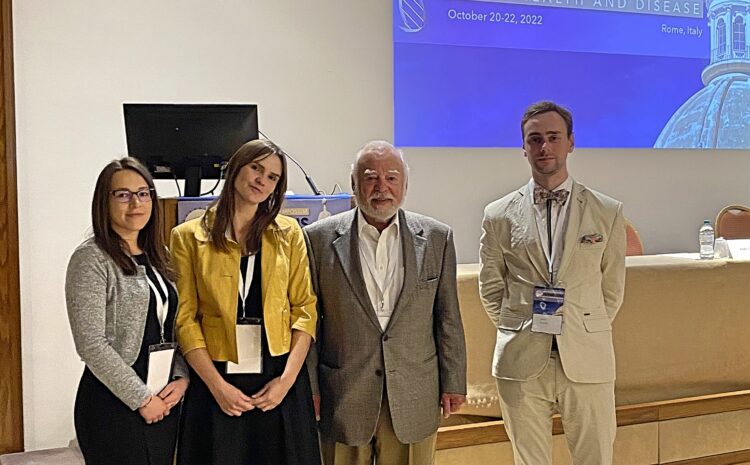
Interesting presentations of Polish scientists at the conference on thymosins in Rome
On October 20-22, 2022, the Sixth International Symposium on Thymosin in Health and Disease was held in Rome. The hosts of the symposium were Washington University of Medicine and Health Science in Washington, University of Rome Tor Vergata and IRCCS San Raffaele in Rome. The main topics of the plenary sessions and the poster session included mainly mechanisms of action, preclinical and clinical use of thymosin α1 and thymosin β4, and thymus extracts and peptides, including the drug TFX, which is a mixture of thymosins (including thymosin α1 and thymosin β4), as well as other resilience topics. Researchers from 12 countries gave a total of 34 presentations, including 9 online. There was 15 minutes for each presentation and 5 minutes for discussion.
The conference began with speeches by Professors Allan L. Goldstein from the George Washington University in Washington and Enrico Garaci from the University of Rome San Raffaele in Rome. Professor Garaci expressed his gratitude that despite the difficulties related to the COVID-19 pandemic, the symposium was organized. The professor called thymosins interesting molecules and compared them to an iceberg – the properties known to us so far are only the tip, and expressed his belief in their huge potential. Then, a short speech was given by Professor Goldstein – the co-discoverer of thymosin and a great authority in the field. The main opening speeches of the symposium were given by dr. Anna Teresa Palamara and dr. Ildiko Bock-Marquette. Both speakers were honored with the Abraham White Award for social action and pioneering research and scientific contributions, respectively.
On the second day of the symposium, the results of research and discoveries were presented, divided thematically into three plenary sessions and a poster session. The first session focused mainly on the clinical use of Tα1, the second focused on thymosin β4, and the third was dominated by research into the treatment of Tα1 in COVID-19 patients. During the poster session, the research of young scientists and a memorial for Dr. Luc Montagnier, co-discoverer of the HIV, whose work has had an impact on our understanding of the immune system.
In the evening, an awards banquet was held, at which, in addition to the aforementioned awardees, were also honored James E. Talmadge, for lifetime discoveries in the field of immunology and cancer research, and Archbishop Vincenzo Paglia, for humanitarian service to peace, dialogue, bioethics and promoting human dignity. Talmage also gave a keynote speech on the most important historical and current immune interventions in the treatment of cancer.
On Saturday, the last day of the conference, there were two plenary sessions focusing mainly on thymus extracts and peptides. Presentations by Polish scientists were particularly interesting. The first, by Dr. Joanna I. Lachowicz from the Faculty of Medical Sciences and Public Health of the University of Cagliari in Italy, investigated the metal-driven biochemistry of thymosin β4. The data presented supported the hypothesis that the necessary coordination of metal ions is the driving force behind Tβ4 ferroptosis switching and cellular translocation, with downstream effects on tissue development and regeneration, tumor metastasis and neurodegeneration. The second was by Prof. Aleksander B. Skotnicki from the Department of Hematology of the Jagiellonian University in Krakow, who presented a review of the immunological activity of the TFX calf thymus extract and its therapeutic benefits. Professor Skotnicki also presented the history of thymotherapy, i.e. therapy with the use of thymic peptides. He pointed out that TFX is a safe, non-toxic preparation of hormones derived from calf thymus, capable of restoring immune system function in immunocompromised patients by acting not only on immature T cells, but also indirectly on the maturation and function of other cell types. TFX is a mixture of naturally occurring thymus peptides with a molecular weight of less than 10 kDa and contains, among others, thymosin beta 4 and thymosin alpha 1, so it shows all the activities of these peptides, as well as the additional benefits of a complex drug composition. Professor Skotnicki explained that the use of multicomponent preparations is more beneficial due to the differentiation of the biological effects of their individual components, which translates into a better immunocorrective or reconstructive effect. In addition, thymus peptides of natural origin contain complex substances that, when applied, cause a tissue-specific trophic effect on the thymus, restore T cells function and host immunity. All these features mean that TFX can exhibit bidirectional immunomodulatory activity on the biological response, because on the one hand it increases the activity of cytotoxic CD8+ lymphocytes, and on the other – by affecting the functions of regulatory T cells – it controls and inhibits excessive auto- and alloreactivity. Thymotherapy is physiological and responds to the systemic homeostatic “demand” by regulating existing disorders.
At the end of the conference, Professors Garaci and Goldstein gave a speech, expressing their great joy at the success of this year’s symposium and expressed the hope of organizing another symposium with even more participants and even more advanced scientific breakthroughs. As part of their participation in the symposium, all presenting scientists will have the opportunity to publish their articles in the renowned journal International Immunopharmacology – in a special issue dedicated to thymosins.
